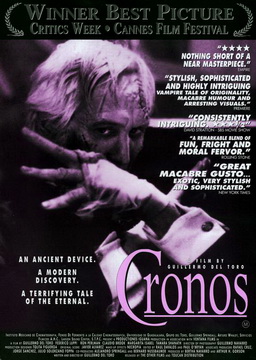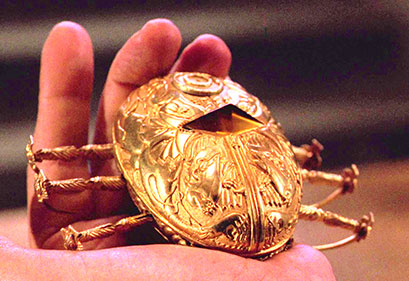 A bold and ingenious variation on vampire mythology, this was the stunning feature film debut of Mexico’s Guillermo Del Toro, a filmmaker who should really Need No Introduction.
A bold and ingenious variation on vampire mythology, this was the stunning feature film debut of Mexico’s Guillermo Del Toro, a filmmaker who should really Need No Introduction.
…the stunning feature film debut of Mexico’s Guillermo Del Toro,…
CRONOS (1993) was allegedly the most expensive Mexican film ever made at the time. That’s despite the fact that its writer and director was a 28-year-old first timer who raised much of the financing himself, and handled the special effects through his own company Necropia. He also managed to attract top-flight talent like Federico Luppi (often called the greatest living Hispanic actor), onetime Luis Bunuel regular Claudio Brook and the American Ron Perlman, who’d go on to appear in Del Toro’s BLADE II (2002), HELLBOY (2004) and HELLBOY II: THE GOLDEN ARMY (2007).
Other subsequent Del Toro films include MIMIC (1997), THE DEVIL’S BACKBONE (EL ESPINAZO DEL DIABLO; 2001), PAN’S LABYRINTH (EL LABERINTO DEL FAUNO; 2006) and THE SHAPE OF WATER (2017). The genesis of those films can be found in the modestly conceived CRONOS, which relates the tale of Jesus, a kindly old antiques dealer who discovers what looks like a chunk of gold inside an ancient statue.
What Jesus doesn’t initially realize is that the golden thing is actually a mythical artifact known as a Cronos Device. It’s a contraption housing an insect whose sting, through the machinations of the device, confers immortality on its victims—but with a price. That price makes itself apparent as Jesus becomes addicted to the device’s sting and, in turn, to human blood. As his addictions deepen Jesus finds his flesh rotting and flaking off, to reveal a pasty white epidermis underneath.
But there’s also De la Guardia, an eccentric industrialist who lives alone in a large house together with his brutish assistant Angel. De la Guardia has been searching for the Cronos Device all his life, and upon learning that Jesus may possess the object dispatches Angel to forcibly extract it. But they don’t count upon Jesus’s unexpected reservoir of strength, or his resourceful young granddaughter.
What Jesus doesn’t initially realize is that the golden thing is actually a mythical artifact known as a Cronos Device.
Viewers of Guillermo Del Toro’s later films will recognize many of their elements in embryonic form: an overriding affinity for the grotesque, a fascination with childhood wonder and trauma, and a thorough knowledge of genre lore past and present. The films Del Toro references in CRONOS are too numerous to fully cover in this review (they include EYES WITHOUT A FACE, BLACK SABBATH, PHANTOM OF THE PARADISE and SUSPIRIA), as are the many symbols and portents he utilizes. The blood-sucking Cronos Device is redolent of vampirism, certainly, but also, as Del Toro has pointed out repeatedly, the ancient science of alchemy.
As a piece of filmmaking CRONOS is well-paced and stylishly visualized, with many impressive low-budget special effects. Particularly ingenious are the views inside the Cronos Device, a busy environ packed with spinning gears whose depictions might seem inconsequential (the producers apparently told Del Toro to scrap ‘em) but contribute immeasurably to the film’s excellence. The fantastic world Del Toro creates works precisely because of his attention to detail.
On the downside, CRONOS overall is probably not as dark or disturbing as it could (or should) be considering the gruesome subject matter—although Del Toro would go on to rectify that complaint quite decisively in THE DEVIL’S BACKONE and PAN’S LAYBYRINTH.
Vital Statistics
CRONOS
Producciones Iguana
Director: Guillermo Del Toro
Producers: Bertha Navarro, Arthur H. Gorson
Screenplay: Guillermo Del Toro
Cinematography: Guillermo Navarro
Editing: Raul Davalos
Cast: Federico Luppi, Ron Perlman, Claudio Brook, Margarita Isabel, Tamara Shanath, Daniel Gimenez Cacho, Mario Ivan Martinez, Farnesio De Bernal, Juan Carlos Colombo, Jorge Martinez De Hoyos, Luis Rodriguez, Javier Alvarez

